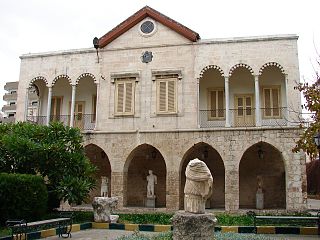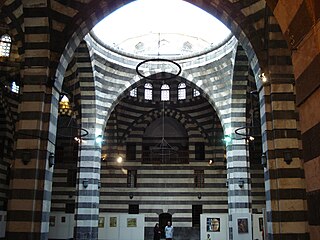 W
WThis is a list of museums in Syria.National Museum of Damascus National Museum of Aleppo National Museum of Latakia National Museum of Tartous National Museum of the Arts and popular Traditions of Syria Palmyra Museum Deir ez-Zor Museum Raqqa Museum Homs Museum Idleb Museum Suweida Museum Ma'arrat al-Nu'man Museum Qalaat al-Madiq (Citadel) Arwad Museum (Citadel) Bosra Museum (Citadel) Archeological Museum of Shahba Apamea Museum Ebla Museum Amrit Museum Khan As'ad Pasha Azm Palace Azm Palace (Hama) Aleppo Citadel Museum Beit Ghazaleh Beit Achiqbash Beit Junblatt (Aleppo) Al-Shibani Church Khanqah al-Farafira Maktab Anbar Nur al-Din Bimaristan Tomb of the Unknown Soldier (Damascus) Al-Khatt al-Arabi Museum of Epigraphy (Damascus) Al-Bayt al-Shami Damascus Museum of Agriculture
 W
WAl-Shibani Church, also known as al-Shibani School, is a 12th-century religious and cultural centre located in "al-Jalloum" district of the Ancient City of Aleppo, Syria. The complex is located to the west of the al-Saffahiyah Mosque and of the south of Suq Khan al-Nahhaseen.
 W
WKhan As'ad Pasha is the largest Caravanserai in the Old City of Damascus, covering an area of 2,500 square metres (27,000 sq ft). Situated along Al-Buzuriyah Souq, it was built and named after As'ad Pasha al-Azm, the governor of Damascus, in 1751-52. Khan As'ad Pasha has been described as one of the finest khans of Damascus, and the most "ambitious" work of architecture in the city. Throughout the Ottoman era, it hosted caravans coming from Baghdad, Mosul, Aleppo, Beirut and elsewhere in the Middle East.
 W
WAzm Palace is a palace in Damascus, Syria which dates back to the 18th century. Located north of Al-Buzuriyah Souq in the Ancient City of Damascus, the palace was built in 1749 and was the private residence for As'ad Pasha al-Azm, the governor of Damascus, and during the French Mandate for Syria and the Lebanon it housed the French Institute.
 W
WThe Azm Palace is an 18th-century Ottoman-era palace in Hama, Syria at the center of the city on the banks of the Orontes River, about 400 meters (1,300 ft) south of the Hama Citadel. Ross Burns, author of Monuments of Syria, reportedly considers the Azm Palace to be "one of the loveliest Ottoman residential buildings in Syria."
 W
WBeit Ghazaleh is one of the largest and better-preserved palaces from the Ottoman period in Aleppo. It was named after the Ghazaleh family that owned it for about two centuries. Since 1914, it was used as a public school and was recently restored to host the Memory Museum of the city of Aleppo. Beit Ghazaleh is located in the Al-Jdayde district of Aleppo.
 W
WBeit Junblatt is a historic mansion in Aleppo, Syria, built in the 16th century by a Kurdish emir of the Jumblatt family.
 W
WThe Cathedral of Our Lady of Tortosa was a Catholic cathedral in the city of Tartus, Syria. Erected during the 12th century, it has been described by historians as "the best-preserved religious structure of the Crusades." The cathedral was popular among pilgrims during the Crusades because Saint Peter was said to have founded a small church there dedicated to the Virgin Mary. After it was captured by the Mamluks, the cathedral was turned into a mosque. Today, the building serves as the National Museum of Tartus.
 W
WNur al-Din Bimaristan is a large Muslim medieval bimaristan ("hospital") in Damascus, Syria. It is located in the al-Hariqa quarter in the old walled city, to the southwest of the Umayyad Mosque. It was built and named after the Zengid Sultan Nur ad-Din in 1154, and later on an extension was added to the main building in 1242 by a physician Badr al-Din. It was restored in 1975 and now houses the Museum of Medicine and Science in the Arab World.
 W
WThe Museum of Raqqa, also known as the Ar-Raqqah Museum or Rakka Museum, is a museum in Raqqa, Syria founded in 1981. The structure housing the museum was built in 1861 and served as an Ottoman governmental building. The museum is dedicated to the preservation of the culture of the Raqqa province.